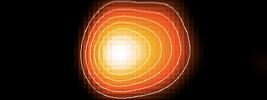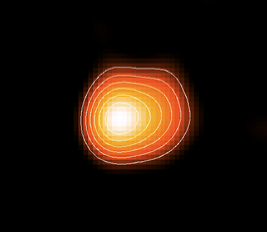
Radio Stars: imaging stellar surfaces at radio wavelengths
Stars emit radio waves through a wide variety of physical processes, depending on the type of star, its age, and its physical properties (e.g., mass, temperature, and chemical composition). Observations of these various types of stellar radio waves provide astronomers with unique insights into how stars are born, evolve, interact with their environments, and eventually die.
Listen to the Radio Stars podcast series on stellar radio astronomy: https://web.mit.edu/haystack-www/radiostars/
Apart from the Sun, most other stars appear from Earth as mere pinpoints of light. However, using powerful arrays of radio interferometers such as the Karl G. Jansky Very Large Array in New Mexico and the Atacama Millimeter/submillimeter Array (ALMA) in northern Chile, it becomes possible to resolve the surfaces of some of the biggest and nearest stars known as red giants.
Red giants, including asymptotic giant branch (AGB) stars and red supergiants (RSGs), are extraordinary luminous stars, shining up to 100,000 times brighter than the Sun, and with diameters up to 1,000 times larger. However, their temperatures are far cooler (T<3500 K), making them appear red in color. The AGB marks one of the final evolutionary stages for stars similar to the Sun, while red supergiants are the late-stage descendants of more massive stars (8–100 solar masses).
Both AGB stars and RSGs have atmospheres that are complex and time-varying. These stars undergo radial pulsations, shocks, and large-scale convective motions, as well as high rates of mass loss through stellar winds, which spew material into the interstellar medium. However, many details about the physics behind these phenomena have long remained poorly understood. Radio observations are particularly important in this regard, since both AGB and RGS stars have radio-emitting layers in their atmospheres known radio photospheres whose properties reveal unique insights into the workings of these stellar behemoths.
Haystack researchers have have several ongoing programs aimed at unlocking the secrets of red giants through high-resolution imaging of their radio photospheres. In parallel, they are pioneering the development of new radio imaging techniques that enable the extraction of more detailed information from stellar radio imaging data than has previously been possible. This work has led to new insights into the fascinating physics that governs the late stages of stellar evolution.
Imaging the radio photospheres of AGB stars with the VLA and ALMA
Background
During the late stages of stellar evolution, low-to-intermediate mass stars similar to our Sun evolve into red giants known as asymptotic giant branch (AGB) stars. AGB stars undergo periods of extensive mass loss through cool, dense winds that pollute the interstellar medium with dust and chemically enriched gas that will ultimately seed the next generation of star formation.
Many aspects of the physics of late-stage stellar mass loss remain poorly understood, including the wind launch geometry and driving mechanism, the timescales of the mass loss, and the variations in the mass loss process for stars with different initial properties. However, observations that resolve the photospheres and extended atmospheres of AGB stars at centimeter, millimeter, and submillimeter wavelengths provide crucial new insights into these questions.

Pictures of giants
Haystack researcher Lynn Matthews has been leading a program that uses the Karl G. Jansky Very Large Array (VLA) in New Mexico and the Atacama Large Millimeter/submillimeter Array (ALMA) in Chile to image the radio surfaces of nearby AGB stars. Remarkably, these observations are able to resolve the surfaces of the target stars, revealing that AGB stars are often highly non-spherical and non-uniform, and that that their appearances can evolve markedly on timescales of months to years (e.g., Matthews et al. 2015).
A key component of this work has been the application of a new class of radio imaging algorithms known as regularized maximum likelihood (RML) methods that enable sharper images of stellar surfaces at radio wavelengths than has been possible previously. RML methods, including the SMILI software package developed by Haystack researcher Kazunori Akiyama, were developed for use by the Event Horizon Telescope Collaboration to enable imaging of supermassive black holes, but have proved to be extremely powerful for stellar imaging as well (see Matthews et al. 2018).
Project team
Focus on Betelgeuse
The red supergiant (RSG) phase marks a short-lived period near the end of the lives of massive stars (roughly 8 or more times the mass of the Sun). RSGs are frequently observed to be losing mass at high rates through cool, low-velocity outflows, and this mass loss has a profound effect on the ultimate evolutionary fate of the star—including whether it will ultimately end its life as a supernova. However, the details of the RSG mass-loss process, including its driving mechanism, geometry, and timescale, are poorly understood. One the most significant challenges for understanding mass loss from RSGs is uncovering the mechanism(s) responsible for heating the outer atmosphere, transporting material from the stellar “surface” into the wind, and ultimately sustaining the outflow.
Standing on the shoulder of Orion
Betelgeuse (also known as α Orionis), visible in the “shoulder” of the constellation Orion, is one of the nearest and brightest RSGs, making it one of the largest angular diameter stars in the sky. A consequence is that with current instruments it is now possible to spatially resolve the dynamic surface of Betelgeuse over a wide range of wavelengths—from the ultraviolet to the radio. By combining findings derived from such multiwavelength data, astronomers have the opportunity to glean unprecedented new insights into the structure, atmospheric dynamics, energy balance, and mass-loss process of a RSG.
Motivated by these goals, a consortium of more than 20 researchers from around the world (coordinated by Andrea Dupree, Center for Astrophysics | Harvard & Smithsonian) is undertaking an ambitious multi-year program know as the “Months of Betelgeuse (MOB).” MOB members are orchestrating an intensive campaign of multiwavelength observations of Betelgeuse from the ground and space. Haystack researcher Lynn Matthews is leading a component of this program that involves high-resolution radio imaging observations of Betelgeuse using the Karl G. Jansky Very Large Array (VLA) and the Atacama Large Millimeter/submillimeter Array (ALMA).
Haystack project team
Imaging stars with the Next-Generation Very Large Array (ngVLA)
The proposed next-generation Very Large Array (ngVLA) is expected to enable the imaging of astronomical sources in unprecedented detail by providing an order of magnitude improvement in sensitivity and angular resolution compared with existing radio interferometers operating at wavelengths between 3mm and 20cm (1.2-116 GHz). The ngVLA is expected to be a game-changer for the study of radio emission from evolved stars, including stellar imaging. However, exploiting the full power of the ngVLA for studying stars will require that astronomers improve the computer algorithms that they use to make images of astronomical sources from radio wavelength observations.

Haystack scientists Kazunori Akiyama and Lynn Matthews recently explored how a new class of imaging algorithms known as regularized maximum likelihood (RML) methods could be used to further enhance the power of the ngVLA for imaging stellar surfaces. RML methods, including the SMILI software package, were developed for use by the Event Horizon Telescope Collaboration to enable imaging of supermassive black holes, but they have the potential for far broader applications.
Using simulated ngVLA data sets, Akiyama and Matthews showed that the ngVLA will be capable of creating spectacularly detailed “movies” of the dynamic atmospheres of nearby evolved stars, including asymptotic giant branch (AGB) stars and red supergiants. They also showed that RML methods outperform traditional “CLEAN” imaging methods for stellar imaging applications. Their full results are described here.